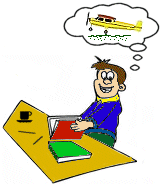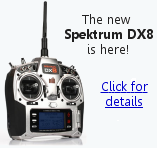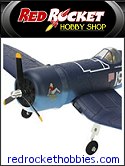If you're thinking of learning to fly rc airplanes, this 'RC Airplane World Ground School' will give you some fundamental information that you need to understand more about the hobby, with the added bonus of there not being an exam at the end!
You've already taken the first step to becoming a confident rc pilot by finding this web site![]() . But now, we've condensed all the important information and advice about learning to fly rc airplanes into the following 10 easy lessons, putting relevant links to the pages where you can read about the topics in more detail.
. But now, we've condensed all the important information and advice about learning to fly rc airplanes into the following 10 easy lessons, putting relevant links to the pages where you can read about the topics in more detail.
And if you get stuck on any words or terms, don't forget to use our rc flying glossary; fun and easy to use, you can find the meanings (serious & humorous) to all the common rc flying words and terms that you're ever likely to hear at the flying field. Any word shown in bold on this page can be found in the glossary.
 So get yourself comfortable, grab a drink and a snack and we'll begin!
So get yourself comfortable, grab a drink and a snack and we'll begin!
Your lessons on learning to fly rc airplanes are...
- How it all works
- How an rc airplane moves and turns
- Number of channels
- Different types of power unit
- Trainer RC airplanes
- RC flight simulators
- Joining a club, learning from an instructor
- Buying your first RC airplane
- Getting airborne
- Practice makes perfect...
1. How it all works
The letters rc stand for radio control. You'll often see rc airplanes referred to asremote control, but technically this is an incorrect term. Radio control is the correct term because the airplane is controlled by radio signals that pass through the air from the transmitter (abbreviated to 'tx') to the receiver(abbreviated to 'rx').
The transmitter is the main box that you hold in your hands, the receiver is located inside the airplane and picks up the signals sent out from the transmitter.
The radio signals are sent to the model in the same way as television and radio broadcasts are sent. Signals are generated whenever you move a stick or flick a switch on the tx, and are emitted via the antenna. All radio signals operate on a frequency, measured in megahertz (MHz*). The transmitter and receiver must be on the same frequency for them to work together, and the gadget that determines the frequency is called a crystal. Both the tx and rx need a matching crystal to function.**
*MHz is slowly giving way to the new GHz (gigahertz) system - 2.4GHz to be exact, or 'spread spectrum' technology.
**Spread spectrum sets don't require a crystal, as the technology is slightly different.
Once the radio signal is picked up by the receiver, via the receiver antenna, it is converted into physical movement by the servos. Servos are connected to the control surfaces of the airplane by servo rods, or connecting rods, so any movement of the servo is passed directly to the control surface that it is connected to.
For more information on how it all works:
- Radio control gear - what it is, what it does
- Radio control functions - what an rc set can do
- Radio control frequencies for rc airplanes (MHz)
- Spread spectrum radio gear
2. How an rc airplane moves and turns
So now you know how radio signals are sent to the airplane when you operate the transmitter, but why does the model do what it does when you move the sticks?
All controllable airplanes have control surfaces and different control surfaces do different things.
The primary control surfaces are rudder, elevators and ailerons. The most basic rc airplanes will only have rudder control; the rudder is the moveable section (hinged) of the vertical stabilizer, or fin, at the rear end of the airplane. It controls the directional movement of the airplane, or yaw; when the rudder moves left, the plane turns to the left and when the rudder moves right the plane turns to the right.
The elevators are the moving section (hinged) of the horizontal stabilizer, or tailplane, also at the rear of the airplane. Elevators control the pitch attitudeof the airplane - whether the nose of the plane is pointing up, down or level.
When elevators are moved up, the airplane will point upwards and thus begin to climb. If the elevators are moved down, the opposite happens. When the elevators are held level, then the airplane will fly level.
The ailerons are the moving sections (hinged) of each wing and are located on the trailing edge (rear) of each wing towards the outer end, or wing tip. Ailerons always come in pairs, one left and one right, and they move in opposite directions to each other. That's to say that when one moves up, the other moves down and vice versa.
Ailerons control the roll of the airplane; left aileron up / right aileron down causes the plane to roll to the left, right aileron up / left aileron down causes the airplane to roll to the right.
Ailerons used in conjunction with the elevators have the same effect as the rudder ie directional control.
For more information on how airplanes move and turn:
3. Number of channels
Every operation that is controllable on an rc airplane is referred to as a 'channel'.
The most basic plane will be just one channel which could be either motor control on/off (electric) or rudder movement. A typical nitro airplane will be 4 channel - you have control over 4 things; the motor, elevator, rudder and ailerons.
A more complex rc airplane will have those 4 controls plus retractable undercarriage and landing flaps, making it a 6 channel model.
For the majority of rc pilots 2,3 or 4 channel models are the most popular.
For more information on how airplanes move and turn:
4. Different types of power unit
With the exception of rc gliders, all rc airplanes need a motor of some kind to generate the thrust that pushes the model through the air.
The main two types of motor are glow plug (often called 'nitro', 'gas' or collectively 'IC' [internal combustion]) and electric. There are many many different choices of both glow plug and electric motor available and the size of the motor depends on the size and weight of the model, as well as the desired performance.
RC airplanes powered by glow plug engines are faster and bigger but they require certain items of field equipment to get them started. Electric motors need only the battery pack and are quieter and cleaner making them a very popular choice, especially with beginner rc pilots.
Traditionally, glow plug airplanes were more common but these days electric ones are rapidly catching up in terms of popularity.
For more information on power units:
5. Trainer RC airplanes
Learning to fly rc airplanes is best done on a trainer. These are planes that have certain built-in design characteristics to make them nice and stable in the air.
The biggest giveaway is the position of the wing in relation to the fuselage. If the wing sits on top of the fuse, then the chances are that the model is indeed a trainer. High wing airplanes always make the best trainers because they are very stable and forgiving; the weight of the fuselage underneath the wing means that the airplane will always want to naturally level itself out if left to fly on its own (providing that it is correctly trimmed by the pilot).
Another giveaway is the amount of dihedral - the upward angle of the wings when looked at from the front of the airplane. More dihedral means more stability in the air, and easier flying.
When learning to fly rc, always go for a trainer style airplane before any other.
For more information on trainer airplanes:
6. RC flight simulators
RC flight simulators are a great way of learning to fly radio control airplaneswithout having to actually buy one.
The flight simulator is software that runs on your home computer, and will either have its own transmitter or will let you use your own transmitter to power the software. Modern rc flight simulators running on a modern, powerful pc are extremely realistic and an excellent training aid.
Particularly helpful for budding rc helicopter pilots, rc flight simulators mean that you can gain confidence and reflexes before you fly for real; it really doesn't matter if you crash a virtual model!
For more information on rc flight simulators:
7. Joining a club, learning from an instructor
Without doubt this is by far the best way of learning to fly rc airplanes!
The majority of rc airplane clubs will have at least one instructor that can teach you and some clubs even have a club trainer airplane, so you can 'fly before you buy'.
RC airplane clubs are very popular these days and rc pilots are a friendly bunch. Even if you don't have a model and you're just thinking about learning to fly, getting along to a local club is a great idea. You can talk to modelers and gain lots of useful tips and advice.
For more information on joining a club:
8. Buying your first RC airplane
This is a decision that shouldn't be taken lightly, but the time will come when you're ready to start learning to fly rc airplanes for real.
You now know that trainer airplanes are the best ones to go for, but what about the size? This largely depends on where you'll be flying it, and this has to be one of your primary concerns.
If you're thinking of flying it in a public place such as a park or sports field, then a small to medium size electric model is a good choice. Buying an RTF airplane will save you a lot of time and trouble and also money because rc airplanes are nearly always cheaper to buy as a package deal rather than buying everything (model, engine, radio control gear and accessories) separately.
Glow plug airplanes can only really be flown at proper flying club fields or on private land, not only because of the noise but also because the amount of airspace that they need is larger because of their faster flying speed.
Of course, you may own or have access to privately owned land (such as farmland) where you can comfortably fly a larger model away from the public. This is great and will give you more options when considering which model to buy.
Throughout this web site, you'll see links to particular rc airplanes (and other models). All of the models mentioned in this site have been carefully chosen because they are perfectly suitable for anyone learning to fly rc airplanes, and indeed have been designed for exactly that.
But if you're not happy about buying a model online without seeing it first, then the best thing to do is to get along to your local hobby shop and talk to someone face to face. Hobby shop owners have a lot of knowledge when it comes to their products and will be only too pleased to help you make a decision on a suitable model, especially if the corner of your wallet is poking out of your trouser pocket.
If you want to buy online, try:
9. Getting airborne
Rather than give this lesson here, visit the RC Airplane World flight schoolpages.
10. Practice makes perfect (almost)
Once you've got the basic feel of flying rc airplanes, there's one sure way to improve your flying skills - practice!
But be prepared to have the odd 'air incident'... Any rc pilot who tells you he or she has never crashed a model plane obviously hasn't been flying one for long enough! RC airplane crashes are, sadly, all part of the fun and you will damage your model at some point in time. But don't worry! Just keep practicing as often as you can and you'll quickly improve your skills and become much more confident with your airplane.
The most important thing to do is enjoy the flying and laugh at the crashes! (so long as no-one gets hurt...)
Hopefully now you know a lot more about learning to fly rc airplanes than you did at the start of this page!
Please continue to browse RC Airplane World, use the links on this page or thesite map to find out even more about this great, addictive and increasingly popular pastime and why it's just "silly not to do it!".
Related pages
![]() Training methods - ways of learning how to fly rc airplanes and helicopters.
Training methods - ways of learning how to fly rc airplanes and helicopters.
![]() RC airplane controls - the primary ones and what they do.
RC airplane controls - the primary ones and what they do.
![]() How to fly airplanes - RC flight school for beginners.
How to fly airplanes - RC flight school for beginners.
![]() RC flight simulators - the safest way of learning.
RC flight simulators - the safest way of learning.
![]() RealFlight G4 sim - a closer look at a modern rc flight simulator
RealFlight G4 sim - a closer look at a modern rc flight simulator
![]() RC flying do's and don'ts - some basic safety tips.
RC flying do's and don'ts - some basic safety tips.
![]() RC flying FAQ - some common questions about getting in to rc flying.
RC flying FAQ - some common questions about getting in to rc flying.
![]() RC flying glossary - meaning to common flying phrases and words.
RC flying glossary - meaning to common flying phrases and words.
Radio recommendation
Learn to fly RC!
The Beginner's Guide To Flying RC Airplanes eBook is the essential companion if you're thinking about getting in to this fun and exhilarating hobby.
Step-by-step guidance all the way from choosing a suitable plane to your first successful flights!
Downloadable in minutes,more info here.
Looking to shop?
See also
Related pages include...





No comments:
Post a Comment